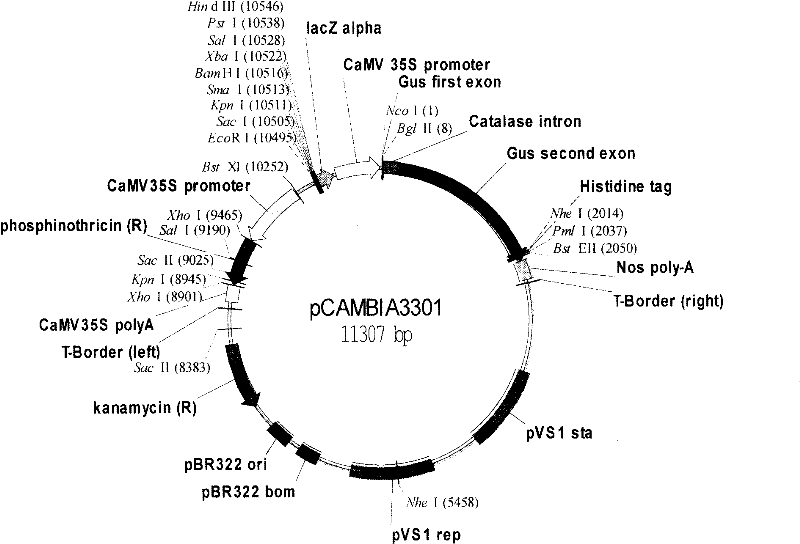Novel method of soybean genetic transformation independent of tissue culture by taking soybean cotyledonary node as receptor
A technology of tissue culture and genetic transformation, which is applied in the field of improving the efficiency of genetic transformation of transgenic soybeans, and can solve the problems of long cycle, restriction of research and development of soybean genetic transformation, and low survival rate of transplanting.
- Summary
- Abstract
- Description
- Claims
- Application Information
AI Technical Summary
Problems solved by technology
Method used
Image
Examples
Embodiment 1
[0018] Obtaining herbicide-resistant transgenic plants by transforming cotyledonary nodes independent of tissue culture
[0019] 1) Materials: soybean variety Tiefeng 31, collected in the experimental field of Jilin Normal University.
[0020] 2) Strains and plasmids: Agrobacterium strain EHA105 was preserved by the Institute of Ecology and Environment of Jilin Normal University, the transformation vector was CaMV 35S as a promoter, and the pCAMBIA 3301 plant binary expression vector (produced by Gift from researcher Zhao Guilan of Jilin Academy of Agricultural Sciences), introduced Agrobacterium tumefaciens strain EHA 105 as a genetically engineered bacterium to transform soybean cotyledon nodes. figure 1 is a diagram of the structure of a binary vector.
[0021] 3) Acquisition of seedlings: Sow soybean seeds into the soil matrix. After 5-7 days, after the cotyledons turn green and unfold, use a scalpel to clean the terminal buds and axillary buds, and then draw 5-6 knives a...
Embodiment 2
[0030] Transformation of Soybean with GUS Gene by Cotyledonary Node Transformation Method Independent of Tissue Culture
[0031] 1) Materials: soybean variety Tiefeng 31, collected in the experimental field of Jilin Normal University.
[0032] 2) Strains and plasmids: Agrobacterium strain LBA4404-PBI121 was preserved by the Institute of Ecology and Environment, Jilin Normal University, and the binary vector pBI121-GUS contains a 35s promoter, a GUS reporter gene, and karamycin as a selective resistance gene.
[0033] 3) Acquisition of seedlings: soybean seeds will be sown into the soil matrix on May 1. After 5-7 days, after the cotyledons turn green and unfold, use a scalpel to remove the terminal buds and axillary buds, and then draw 5 along the direction of the veins. - 6 knives, about 3-4mm long and 0.5mm deep.
[0034] 4) Pick a single colony from the Agrobacterium LBA4404-PBI121-GUS plate, inoculate it in YEB medium containing antibiotics, and culture it with shaking at ...
PUM
 Login to View More
Login to View More Abstract
Description
Claims
Application Information
 Login to View More
Login to View More - R&D
- Intellectual Property
- Life Sciences
- Materials
- Tech Scout
- Unparalleled Data Quality
- Higher Quality Content
- 60% Fewer Hallucinations
Browse by: Latest US Patents, China's latest patents, Technical Efficacy Thesaurus, Application Domain, Technology Topic, Popular Technical Reports.
© 2025 PatSnap. All rights reserved.Legal|Privacy policy|Modern Slavery Act Transparency Statement|Sitemap|About US| Contact US: help@patsnap.com

